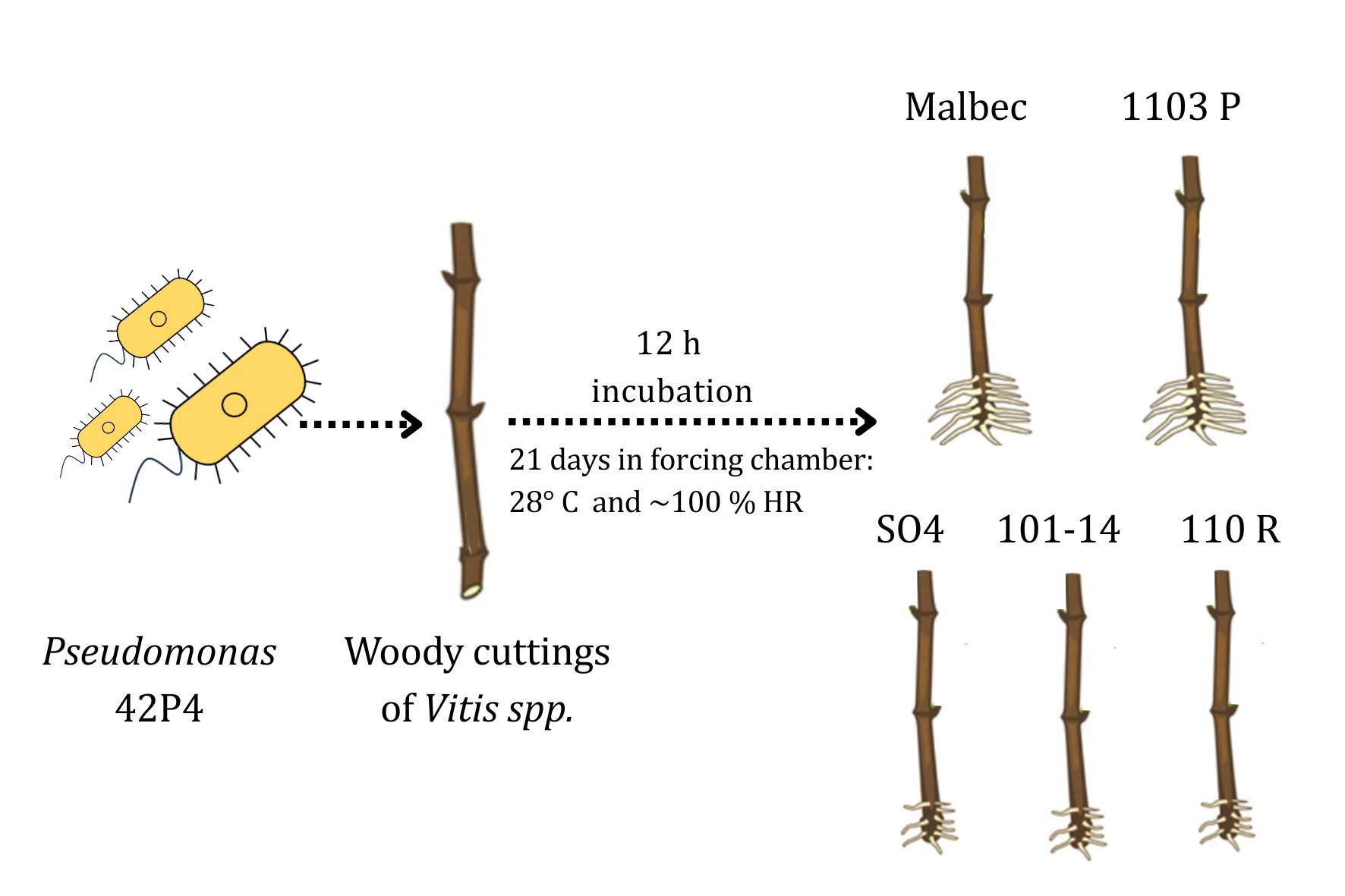The Native Dryland PGPR ‘Pseudomonas 42P4’ Promotes Adventitious Rooting in Woody Cuttings of Vitis spp.
Keywords:
PGPR, grapevine rootstock, Malbec, rooting, graft union, nurseryAbstract

This study evaluated the effect of two native PGPR strains from an arid region (Mendoza, Argentina) on the rooting of woody cuttings of Vitis spp. These strains are known for their growth-promoting capacity, including auxin production. Dormant V. vinifera cv. Malbec cuttings were grafted onto four rootstocks - 1103 Paulsen, 110 Richter, 101-14 MGt and SO4. Then, basal ends of these grafted cuttings and own rooted controls were incubated for 12 h in solutions of (1) Pseudomonas 42P4 at 107 CFU mL-1, (2) Enterobacter 64S1 at 107 CFU mL-1, (3) autoclaved LB medium, (4) water, and (5) a quick-dip immersion of Indole-3-butyric acid (IBA). After treatment, the cuttings were placed in a forcing chamber at 28°C and relative humidity ~100% for 21 days. Rooting parameters and scion-rootstock union percentages were recorded. Pseudomonas 42P4 significantly promoted rooting in Malbec own-rooted cuttings. However, Enterobacter 64S1 had negative or null effects. Furthermore, Pseudomonas 42P4 enhanced rooting in Malbec grafted onto 1103 Paulsen, but not on 101-14 MGt, 110 Richter or SO4. This strain also improved graft union success on SO4, but did not affect the other rootstocks. These results suggest that a dryland native strain such as Pseudomonas 42P4 could sustainably enhance the quality of both own-rooted and grafted grapevine plants in commercial nurseries.
Highlights:
- Pseudomonas 42P4, a native PGPR strain from arid soils, has genotype-specific effects during grapevine propagation.
- Pseudomonas 42P4 promotes rooting in own-rooted Malbec woody cuttings and in Malbec grafted onto 1103 Paulsen.
- Pseudomonas 42P4 might be a sustainable alternative to synthetic auxins in commercial nurseries.
Downloads
References
Atak, A. (2024). Climate change and adaptive strategies on viticulture (Vitis spp.). Open Agriculture, 9, 1-16. https://doi.org/10.1515/opag-2022-0258 Bartolini, S., Carrozza, G., Scalabrelli, G., & Toffanin, A. (2017). Effectiveness of Azospirillum brasilense Sp245 on young plants of Vitis vinifera L. Open Life Sciences, 12, 365-372. https://doi.org/10.1515/biol-2017-0042
Berdugo, M., Delgado-Baquerizo, M., Soliveres, S., Hernandez-Clemente, R., Zhao, Y., Gaitan, JJ, Gross, N., Saiz, H., Maire, V., & Lehmann, A. (2020). Global ecosystem thresholds driven by aridity. Science, 367, 787-790. https://doi.org/10.1126/science.aay5958
Boeno, D., & Zuffellato-Ribas, KC. (2023). A quantitative assessment of factors affecting the rooting of grapevine rootstocks (Vitis vinifera L.). Acta Scientiarum Agronomy, 45. https://doi.org/10.4025/actasciagron.v45i1.57987
Brunoni, F., Vielba, JN, & Sanchez, C. (2022). Plant growth regulators in tree rooting. Plants, 11(6), 805. https://doi.org/10.3390/plants11060805
Burrel, AL, Evans, JP, & De Kauwe, MG. (2020). Anthropogenic climate change has driven over 5 million km2 of drylands towards desertification. Nature Communications, 11, 3853. https://doi.org/10.1038/s41467-020-17710-7
Centeno, A., & Gómez del Campo, M. (2008). Effect of root-promoting products in the propagation of organic olive (Olea europaea L. cv. Cornicabra). HortScience, 43(7), 2066-2069. https://doi.org/10.21273/HORTSCI.43.7.2066
Daskalakis, I., Biniari, K., Bouza, D., & Stavrakaki, M. (2018). The effect that indolebutyric acid (IBA) and position of cane segment have on the rooting of cuttings from grapevine rootstocks and from Cabernet Franc (Vitis vinifera L.) under conditions of a hydroponic culture system. Scientia Horticulturae, 227, 79-84. https://doi.org/10.1016/j.scienta.2017.09.024
D’Innocenzo, SH, Escoriaza, G, Diaz, ME. (2024). First report of the causal agent of vine crown gall in Mendoza, Argentina. Revista de la Facultad de Ciencias Agrarias. Universidad Nacional de Cuyo. Mendoza. Argentina. 56(2): 87-96. DOI: https://doi.org/10.48162/rev.39.139
Di Rienzo, JA, Casanoves, F., Balzarini, MG, Gonzalez, L., Tablada, M., & Robledo, CW. (2020). InfoStat 2020/P. https://www.infostat.com.ar/
Flexas, J., Galmés, J., Gallé, A., Gulías, J., Pou, A., Ribas-Carbó, M., Tomas, M., & Medrano, H. (2010). Improving water use efficiency in grapevines: Potential physiological targets for biotechnological improvement. Australian Journal of Grape and Wine Research, 16, 106 121. https://doi.org/10.1111/j.1755-0238.2009.00057.x
Galet, P. (1993). Précis de viticulture. Dehan Ed. Garay-Arroyo, A., de La Paz Sánchez, M., García-Ponce, B., Álvarez-Buylla, ER & Gutiérrez, C. (2014). La homeostasis de las auxinas y su importancia. Revista de Educación Bioquímica, 33(1), 13-22.
Glick, BR. (2012). Plant growth-promoting bacteria: Mechanisms and applications. Scientifica, 2012, 963401. https://doi.org/10.6064/2012/963401
Gordillo, MG, Cohen, AC, Roge, M., Belmonte, M., & González, CV. (2022). Effect of quick-dip with increasing doses of IBA on rooting of five grapevine rootstocks grafted with ‘Cabernet Sauvignon’. Vitis, 61(3), 147-152. http://dx.doi.org/10.5073/vitis.2022.61.147-152
Hartmann, HT, Kester, DE, Davies, FT, Jr., & Geneve, RL. (2014). Plant propagation: Principles and practices (8th ed.). Pearson. Instituto Nacional de Vitivinicultura. (2023). Superficie cultivada con viñedos en Argentina. https://www.argentina.gob.ar/inv/vinos/estadisticas
Isçi, B., Kacar, E., & Altindisli, A. (2019). Effects of IBA and plant growth-promoting rhizobacteria (PGPR) on rooting of ramsey american grapevine rootstock. Applied Ecology and Environmental Research, 17(2), 4693-4705. http://dx.doi.org/10.15666/aeer/1702_46934705
Jarvis, BC. (1986). Endogenous control of adventitious rooting in non-woody species. En M. B. Jackson (Ed.), New root formation in plants and cuttings (p. 137-162). Martinus Nijhoff Publishers. https://doi.org/10.1007/978-94-009-4358-2_6
Jofré, MF, Mammana, S., Pérez-Rodríguez, MM, Silva, MF, Gómez, F., & Cohen, AC. (2024). Native rhizobacteria improve drought tolerance in tomato plants by increasing endogenous melatonin levels and photosynthetic efficiency. Scientia Horticulturae, 329, 112984. http://dx.doi.org/10.1016/j.scienta.2024.112984
Keller, M. (2020). The science of grapevines (3rd ed.). Elsevier. https://doi.org/10.1016/B978-0-12-816365-8.00001-4
Köse, C., Güleryüz, M., Şahin, F., & Demirtaş, İ. (2003). Effects of some plant growth promoting rhizobacteria (PGPR) on rooting of grapevine rootstocks. Acta Agrobotanica, 56(1), 47-52. https://doi.org/10.5586/aa.2003.005
Köse, C., Güleryüz, M., Şahin, F., & Demirtaş, İ. (2005). Effects of some plant growth promoting rhizobacteria (PGPR) on graft union of grapevine. Journal of Sustainable Agriculture, 26(2), 139-147. https://doi.org/10.1300/J064v26n02_10
Lobato Ureche, MA, Perez-Rodriguez, MM, Ortiz, R., Monasterio, RP, & Cohen, AC. (2021). Rhizobacteria improve the germination and modify the phenolic compound profile of pepper (Capsicum annuum L.). Rhizosphere, 18, 100334. https://doi.org/10.1016/j.rhisph.2021.100334
Machado, MP, Mayer, JLS, Ritter, M., & Biasi, LA. (2005). Indole butyric acid on rooting ability of semihardwood cutting of grapevine rootstock ‘VR 043-43’ (Vitis vinifera x Vitis rotundifolia). Revista Brasileira de Fruticultura, 27(3), 476-479. https://doi.org/10.1590/S0100-29452005000300032
Mudge, K., Janick, J., Scofield, S., & Goldschmidt, EE. (2009). A history of grafting. Horticultural Reviews, 35, 437-483. https://doi.org/10.1002/9780470593776.CH9
International Organization of Vine and Wine. (2023). State of the world vine and wine sector. https://www.oiv.int/node
Ollat, N., Bordenave, L., Tandonnet, JP, Boursiquot, JM, & Marguerit, E. (2016). Grapevine rootstocks: Origins and perspectives. Acta Horticulturae, 1136, 11-22. https://doi.org/10.17660/ActaHortic.2016.1136.2
Pantoja Guerra, M., Valero Valero, N., & Ramírez, CA. (2023). Total auxin level in the soil-plant system as a modulating factor for the effectiveness of PGPR inocula: A review. Chemical and Biological Technologies in Agriculture, 10, 6. https://doi.org/10.1186/s40538-022-00370-8
Pérez-Rodríguez, MM, Piccoli, P., Anzuay, MS., Baraldi, R., Neri, L., Taurian, T., Lobato Ureche, MA, Segura, DM, & Cohen, AC. (2020a). Native bacteria isolated from roots and rhizosphere of Solanum lycopersicum L. increase tomato seedling growth under a reduced fertilization regime. Scientific Reports, 10, 1-14. https://doi.org/10.1038/s41598-020-72507-4
Pérez-Rodríguez, MM, Pontin, M., Lipinski, V., Botini, R., Piccoli, P., & Cohen, AC. (2020b). Pseudomonas fluorescens and Azospirillum brasilense increase yield and fruit quality of tomato under field conditions. Journal of Soil Science and Plant Nutrition, 20(3), 1614-1624. https://doi.org/10.1007/s42729-020-00233-x
Pérez-Rodríguez, MM, Pontin, M., Piccoli, P., Lobato Ureche, MA, Gordillo, MG, Funes Pinter, I., & Cohen, AC. (2022). Halotolerant native bacteria Enterobacter 64S1 and Pseudomonas 42P4 alleviate saline stress in tomato plants. Physiologia Plantarum, 174(1), 13472. https://doi.org/10.1111/ppl.13742
R Core Team. (2024). R: A language and environment for statistical computing. R Foundation for Statistical Computing. https://www.R-project.org/
Riaz, S., Pap, D., Uretsky, J., Laucou, V., Boursiquot, JM, & Kocsis, L. (2019). Genetic diversity and parentage analysis of grape rootstocks. Theoretical and Applied Genetics, 132(6), 1847-1860. https://doi.org/10.1007/s00122-019-03320-5
Satisha, J., & Asdule, PG. (2008). Rooting behaviour of grape rootstocks in relation to IBA concentration and biochemical constituents of mother vines. Acta Horticulturae, 785, 121-125. https://doi.org/10.17660/ActaHortic.2008.785.14
Tandonnet, JP, Cookson, SJ, Vivin, P., & Ollat, N. (2009). Scion genotype controls biomass allocation and root development in grafted grapevine: Scion/rootstock interactions in grapevine. Australian Journal of Grape and Wine Research, 16(1), 290-300. https://doi.org/10.1111/j.1755-0238.2009.00090.x
Toffanin, A., D’Onofrio, C., Carroza, GP, & Scalabrelli, G. (2016). Use of beneficial bacteria Azospirillum brasilense Sp245 on grapevine rootstocks grafted with ‘Sangiovese’. Acta Horticulturae, 1136, 24. https://doi.org/10.17660/ActaHortic.2016.1136.24
Waite, H., Whitelaw-Weckert, M., & Torley, P. (2014). Grapevine propagation: Principles and methods for the production of high-quality grapevine planting material. New Zealand Journal of Crop and Horticultural Science, 43(2), 144-161. https://doi.org/10.1080/01140671.2014.978340
Wickham, H. (2016). ggplot2: Elegant graphics for data analysis. Springer-Verlag. https://ggplot2.tidyverse.org
Wilson, PJ, & Van Staden, J. (1990). Rhizocaline, rooting co-factors, and the concept of promoters and inhibitors of adventitious rooting - A review. Annals of Botany, 66(4), 479-490. https://doi.org/10.1093/oxfordjournals.aob.a088051

Published
How to Cite
Issue
Section
License
Copyright (c) 2018 Revista de la Facultad de Ciencias Agrarias UNCuyo

This work is licensed under a Creative Commons Attribution-NonCommercial-ShareAlike 3.0 Unported License.
Aquellos autores/as que tengan publicaciones con esta revista, aceptan las Políticas Editoriales.












.jpg)




